Wondering How should you take care of houseplants during winter? Looking for tips on winter houseplant care? Here are some tips on the changes winter brings to your indoor plant and how to navigate the dark months of the year. Taking care of houseplants in winter requires some adjustments.
Winter creates unique challenges to plant parents. Natural Lighting drops, indoor heating comes and indoor humidity drops severely.
Our winter houseplant care guide helps you know how to keep indoor plants alive and thriving when the snow blows.
Discover how indoor plants react to the changes in your particular winter home climate. And how to support them.
Recognize problems that arise in winter plant care and learn how to fix them.
Read these tips to safely travel indoor plants through the bleak winter months and on into the Spring growing season.
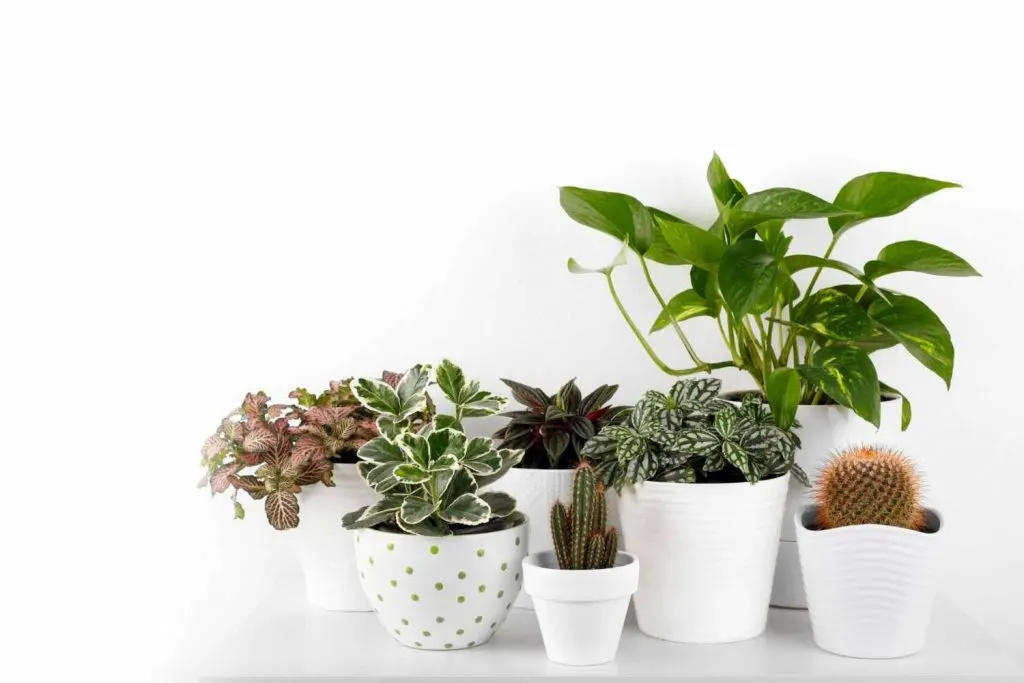
Winter houseplant Care: Lighting:
Your local climate and winter light index have a lot to do with a particular plants reaction to winter in your home.
Plants are very reactive to the light in their environment. Ambient amounts of Natural and artificial light are triggers to plant growth, flowering and dormancy.
Plants naturally slow down growth in winter and take a rest from growing when daylight dims and shortens. Plants will ‘wake’ again in spring when they receive enough light to trigger new growth.
Your plants will require artificial light support through the winter months if they cannot get enough light to survive. This depends on the number of hours of light you get every day, the intensity of the light, and how much light your individual plants require.
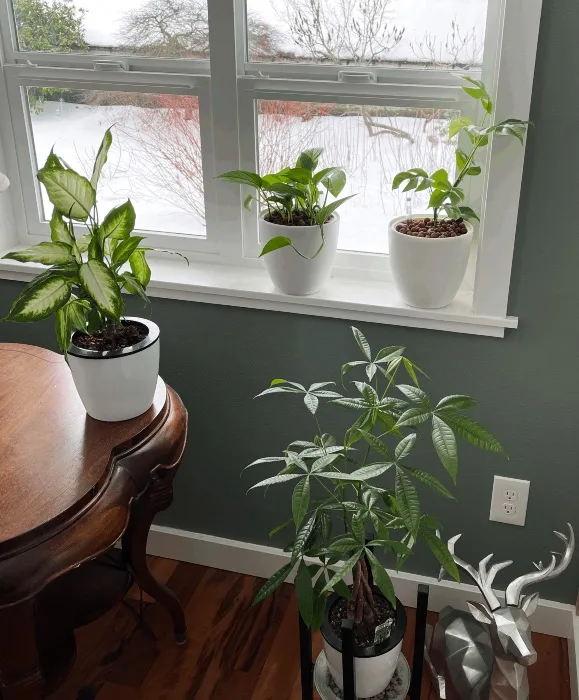
Taking Care Of houseplants in Winter Light:
The hours of useful natural daylight your plants receive in winter depends on your location, Where your windows are located in your home, and how much light your plants can access from them.
Winter light Strategies to consider:
- As winter progresses the sun sits lower in the sky. The sun rays angle get longer and lower.
- This increases access to light through some windows and may help your indoor plants receive better light as slanted sunlight illuminates the room.
- The heat of the sun rays cool in winter as the earth’s orbit spins us further away from its warmth. This means, if your plants get direct light in winter it may be safe for them. You probably won’t have burned leaves from too much sun.
- Snow is reflective. If you have snow on the ground around your home throughout the winter you may have a good amount of winter light reflected into your house.
- Painting your home in light reflective colors also helps light bounce around a room.
Most plants have natural ways to adjust to the available light they receive in a day. Help plants access light by grouping them by bright windows.
How does the sun travel through your home throughout the short days of winter? Take advantage of the precious hours of direct and indirect daylight in your home.
Changes you might see in plants due to lower light:
In lower light conditions winter houseplant care includes managing the natural light to give the dormant plants what they need to do well until the light cycle brightens in spring. House plants will prioritize what they can do metabolically to maintain themselves through the lower light of winter. Dormancy is one method of survival until the light increases and they can get back to growing and thriving.
- Variegated plants new growth reverts to solid green with no variegation.
- Your plants growth will slow down when the days shorten and the light decreases. Many of your plants will go dormant.
- This means you will see little to no new growth.
- If you have flowering plants like a peace lily, they will most likely quit flowering during winter.
- Plants in low light often reach for the light. Leggy thin growth results. Long stems and small leaves indicate too low light for your plant.
These changes are normal plant reactions to lower light than is optimal for them. They will survive until the light improves if conditions are not too extreme or too lengthy.
When to Add Artificial Lighting to houseplants:
When natural daylight is just not enough…
If you are seeing very pale leaves on your plant and sickly looking plants with small leaves and long stretches of stem, artificial lights can help. Artificial lights can get your plants through the dark months.
This is especially helpful if you don’t have enough windows to put plants on for maximum sun exposure. Or if those window sills are too chilly for your plants.
Artificial lights come in all shapes and sizes. The local hardware store has them. Amazon sells them too. choose the ones that best suit your need.
How Often Should I Water Plants In Winter?
Watering is an important part of winter houseplant care. But maybe not in the way you think. Since plants do less growing in winter, managing the proper amount of water is VERY important.
Overwatering plants that are growing less or not at all is extremely easy to do. The plants will use less water in winter when sleeping.
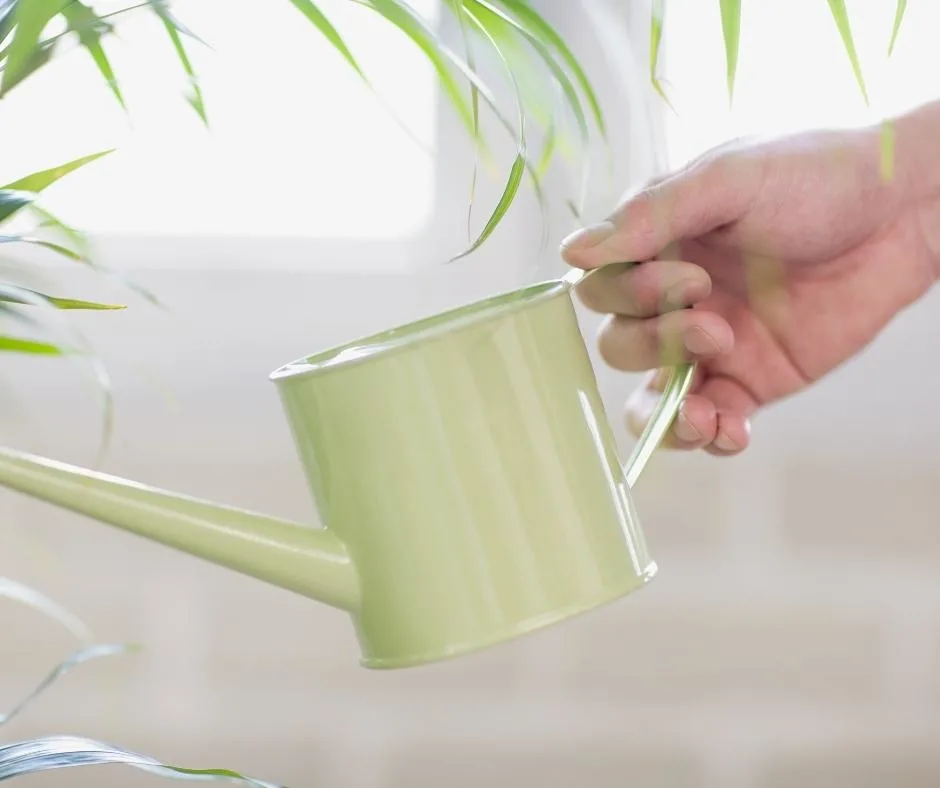
Proper watering is vital to houseplants. Watering is usually the culprit when plants show stress.
The Number ONE problem plant parents have when taking care of houseplants in winter is overwatering. We just love our plants and want to nurture them. But don’t love them to death.
Why Plants Need less Water in Winter:
Winter watering is tricky. Snoozing indoor Plants can go longer without water in winter. Here’s Why.
- Resting Plants slow or stop growth in winter so the plant draws less water to maintain itself.
- Plant soils in low light and cooler temperatures do not dry as quickly as warm soil. Your watering schedule needs to adjust.
Water Plants Less in Winter months. When in doubt use a moisture meter to be sure the plant actually needs water.
Watering Problems
- Plant soils that are constantly saturated eventually suffocate and rot roots. Learn how to fix root rot in this post.
- Signs that your lush tropical plant is overwatered include yellowing leaves, leaf drop and drooping plants.
- Mushy, pale or drooping leaves are often apparent on over watered succulents.
- Under watering, while not as common in winter also stresses plants and results in brown leaves or leaf tips.
- If your plant is showing leaf distress, suspect watering problems.
Tips for watering plants in winter:
- Use room temperature water to avoid shocking the resting plant.
- Water when the plant soil is dry down to the lower root section. I use a moisture meter to make sure the plant is dry down to the bottom before I water. If you use your finger make sure you can go down into the pot halfway. The soil must be dry before you water.
- Saturate the soil so the plant pot drips. Let the pot drain for 10 minutes or so. Then set the pot on the drain plate and leave the plant alone.
- Avoid giving your plant constant small sips of water. The soil will never dry out.
- Stretch out your watering schedule in winter for most plants to at least every two weeks. Some plants can go even longer.
Plants are very beneficial to people emotionally and as an environmental addition to your home.
Read more about why houseplants are beneficial to people here .
The Contented Plant
How Does Humidity Affect Plants In Winter?
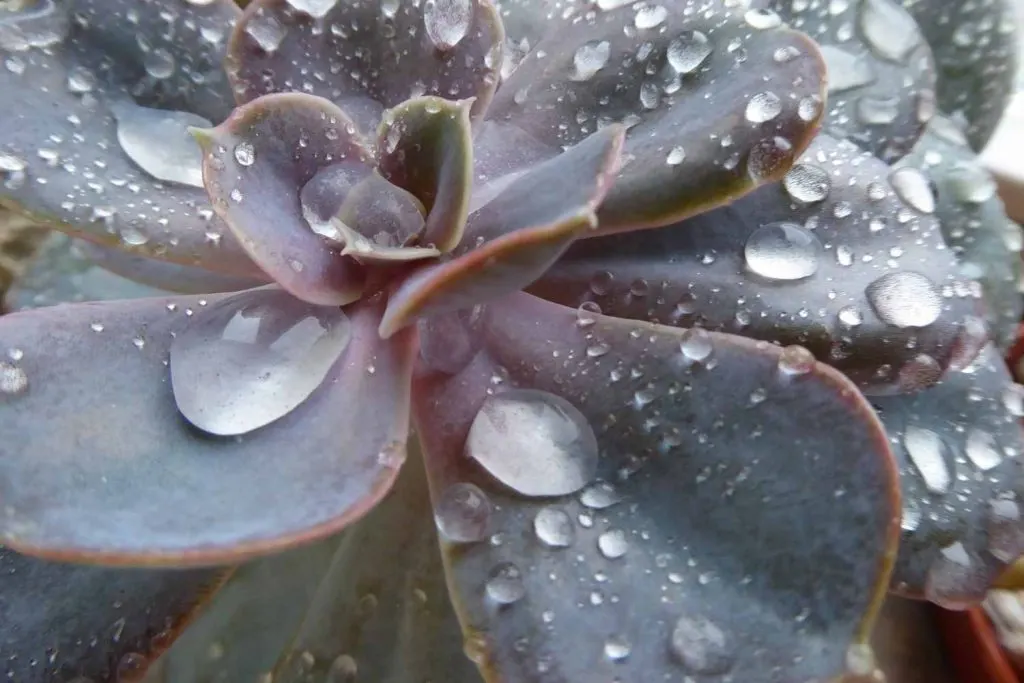
Humidity always drops in winter. Winter houseplant care needs to take this into account. Dry heat from heat vents and drying arctic winds suck moisture from the air. Plants need a certain amount of moisture to stay healthy. Some more than others.
When you start to experience dry lips and skin your home is too dry for you and your tropical plants. Fortunately, Most tropical plants can live happily at 40% humidity or above. Humans enjoy 45%.
For tropical plants, which many of our houseplants are, 40% humidity is the absolute bottom of where they are able to hydrate their leaves.
If your humidity is too low for your plants:
- Sensitive tropical plants, All Calatheas for example but even some succulents like the Zebra Plant, will suffer brown tips on their leaves.
- You may noice the leaf edges start to cup inward as the leaves continue to lose moisture. They cannot adequately hydrate their leaves from their roots. Humidity above 40% is a must.
Succulents have thick fleshy leaves and LOTS of adaptations in their top growth to help retain water for long periods. Succulents can withstand drier heat but you may see brown tips on some. For more on watering succulents successfully read this post.
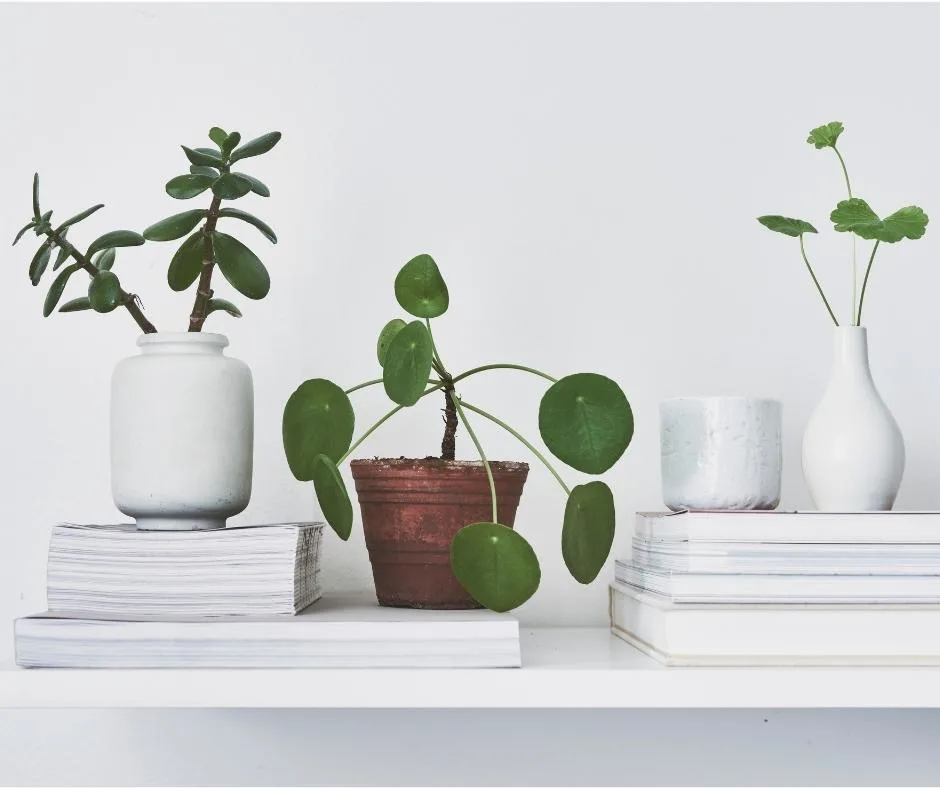
Strive to achieve and maintain 40% humidity in your home year round. Indoor plants thrive at 40 to 60% humidity in general. Here are some
Tips For Raising Humidity around indoor plants.
- If your home dips down into the 30% humidity range you and your plants will enjoy a home humidifier. Humidifiers come in all sorts of sizes. Choose the one best suited to your needs.
- Some people in dry climates dedicate one entire room to their houseplants. They humidify only that one room since it is easier to tackle than a whole house footprint.
- Plants enjoy being close to each other. Plant groupings also keep humidity up around the plants. They respire and evaporate moisture to each other as they grow.
- Pebble trays are shallow trays with pebbles. Add water to these trays and place your plants on the dry surface of the pebbles. Plants enjoy the humidity as water evaporates from the tray.
- Misting plants leaves will help increase humidity. Larger tropical plants like the money tree, Ficus benjamina and Thai Constellation Monsteras can be given occasional showers to clean and hydrate the leaves. (keep succulents leaves dry)
- Move plants with high humidity needs to a adequately lit bathroom or kitchen.
- Keep your plant in a pot with a deep drainage pot. I call this the pot in pot method. My domino peace lily enjoys growing this way.
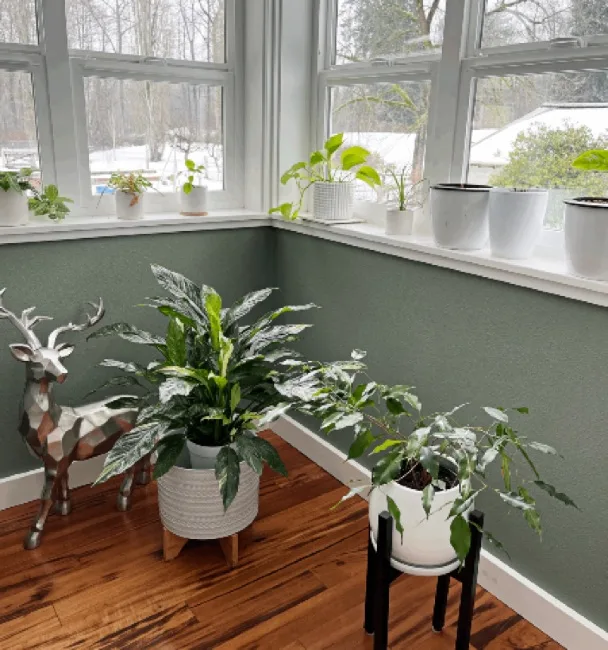
I group several of my Calatheas on a table with lots of pebble trays.
The plants stay hydrated even though the table sits over a heat vent. The heat keeps the table warm for the plants and the water evaporation is high.
The pebble trays and groupings keep the plants humidity over 40%. I refill the trays every few days when the arctic winds come through. North winds dry everything out very quickly.
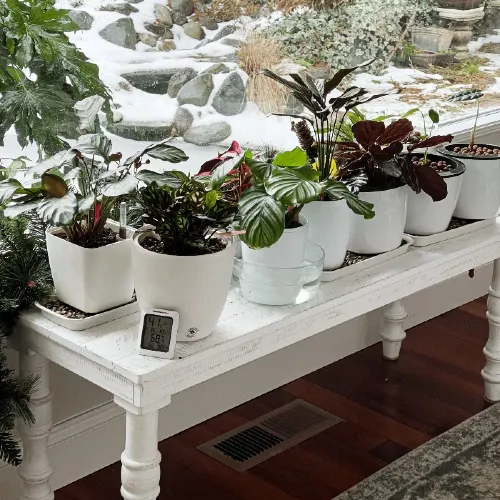
How Does Plant Soil Dry In Winter?
Plant soils dry differently in winter and your winter houseplant care practices will need to be sensitive to the type of soil your plants are growing in. How they dry depends on how dormant the plant is and on the composition of the soil mix you are using. This will be different from plant to plant and the type of climate zone you are in will greatly impact the factors that dry out soil.
- Heavy soils are easily overwatered in winter. They hold water the plant doesn’t need next to the plant roots too long. This can cause root rot in your dozing plants.
- Porous soils will dry much faster. However, sandy soils can form hard crusts and not allow water to the plant roots. A crusted soil repels water. Water flows down the outside of the soil in the pot.
- The plant dries out too much in crusted soil. To fix this, set the plant pot in water and let the plant soak water through the bottom until the soil is saturated.
Safe Temperature Range For Indoor Plants in Winter:
Most houseplants are safe down to 60 degrees F. Many can even drop to 50 degrees F without damage when they are dormant.
So if you are comfortable your plants will be. Watch for strong drafts from heat vents, air conditioning systems and drafty doorways in winter. Fast, extreme temperature changes can shock plants.
Keep your plants in consistent temperatures above 60 degrees and below 75 for the winter.
if you have a power outage and want to save your plants from freezing:
- Keep your plants above 50 degrees F if you can. Heat is a higher priority than light at this point. Bring your plants by your heat source but watch out for extremely hot temperatures next to fireplaces and stoves.
- To conserve heat around plants in extreme cold. Group them into a deep cardboard box stuffed with plastic bags, styrofoam chips or newspaper. Cover the box with plastic.
- Use a small battery operated heater or led light to warm the box or move them to your warmest spot.
- You can also build them a tent of plastic, bubble wrap or glass. Invert a cardboard box over them if it is short term. This will help hold heat and moisture around the plants.
Your plants may go into shock and have some damage but don’t give up on them. Even if all the top growth dies back the plant may come back when the growing season gets going. Wait for spring unless the plant is froze completely.
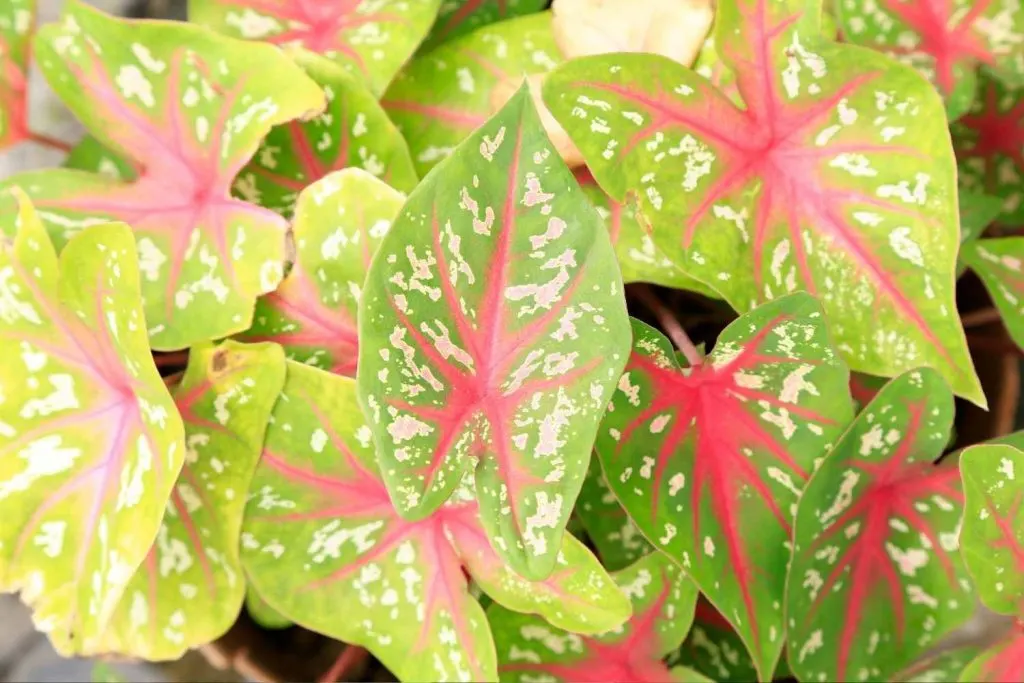
Feeding Houseplants Plants in Winter:
Here we get a break. Winter houseplant care, in this case is easy. When it comes to fertilizing your plants through dormancy…Pretty much, don’t. Plants are resting in winter, rather than growing in most cases. Taking care of houseplants in winter is a study in benign neglect.
If you are trying to force blooms through winter, more than fertilizer is involved.
There are several things that trigger a plant to come up into a blooming state. Temperature and light changes specific to the plant are necessary.
Read up on how to force blooming out of season your particular plant before adding fertilizer in winter.
Over fertilizing will cause the leaves to brown. The plant will suffer if the pot accumulates too many salts from over fertilizing.
If this happens, set your plant under room temperature water and flush the pot through to eliminate the unwanted fertilizer salts.
Is it ok to Repot Plants in Winter?
- Repot a dormant plant only if necessary. (suffering root bind or root rot are reasons to un-pot and repot a plant in winter).
- Repot only to the next size up pot.
- Do not add fertilizer since the plant won’t use it.
- Water sparingly,
- And handle gently during repotting.
Here’s my method for repotting plants year round.
Related Content:
Follow Us:
Find us on YouTube, Instagram , Pinterest and TikTok! We love to Plant chat. We also comment, like and occasionally share your content to our daily stories. We’d love to see your plants. Share your joy in your houseplants. Happy Planting!
Recent Posts:
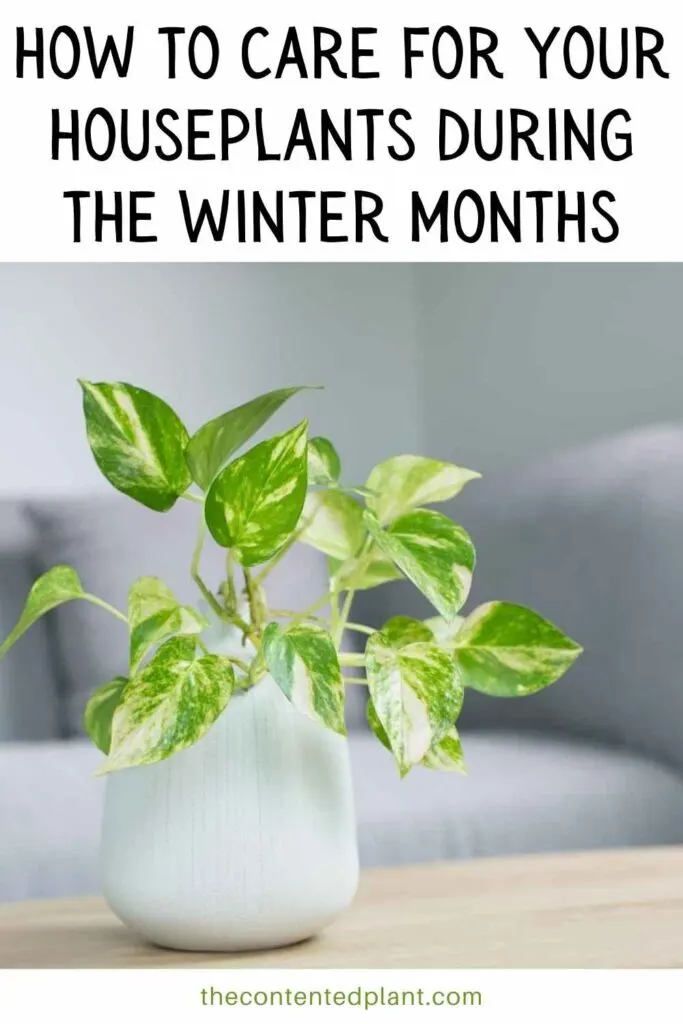

Plant Watering Globes Guide - The Contented Plant
Thursday 13th of October 2022
[…] How to Keep your Houseplants Alive In Winter […]
Watering Succulents-Tips for Success - The Contented Plant
Tuesday 27th of September 2022
[…] Learn How to Keep Your Houseplants Alive in Winter Here […]
How to Grow Herbs Indoors - The Contented Plant
Saturday 10th of September 2022
[…] the dark winter months Keeping your houseplants alive in winter can be a challenge. We can, and should, let our ornamental houseplants go dormant in winter since […]
String of Hearts Watering Guide - The Contented Plant
Thursday 24th of February 2022
[…] String of hearts can go at least two weeks, in most cases, before watering and even more in some cases. A lot of this depends on your plant and pot size, soil type and your home climate. Expect to water more often in winter. […]
Snake Plant Watering Guide - The Contented Plant
Saturday 5th of February 2022
[…] How to Keep your Houseplants Alive In Winter […]